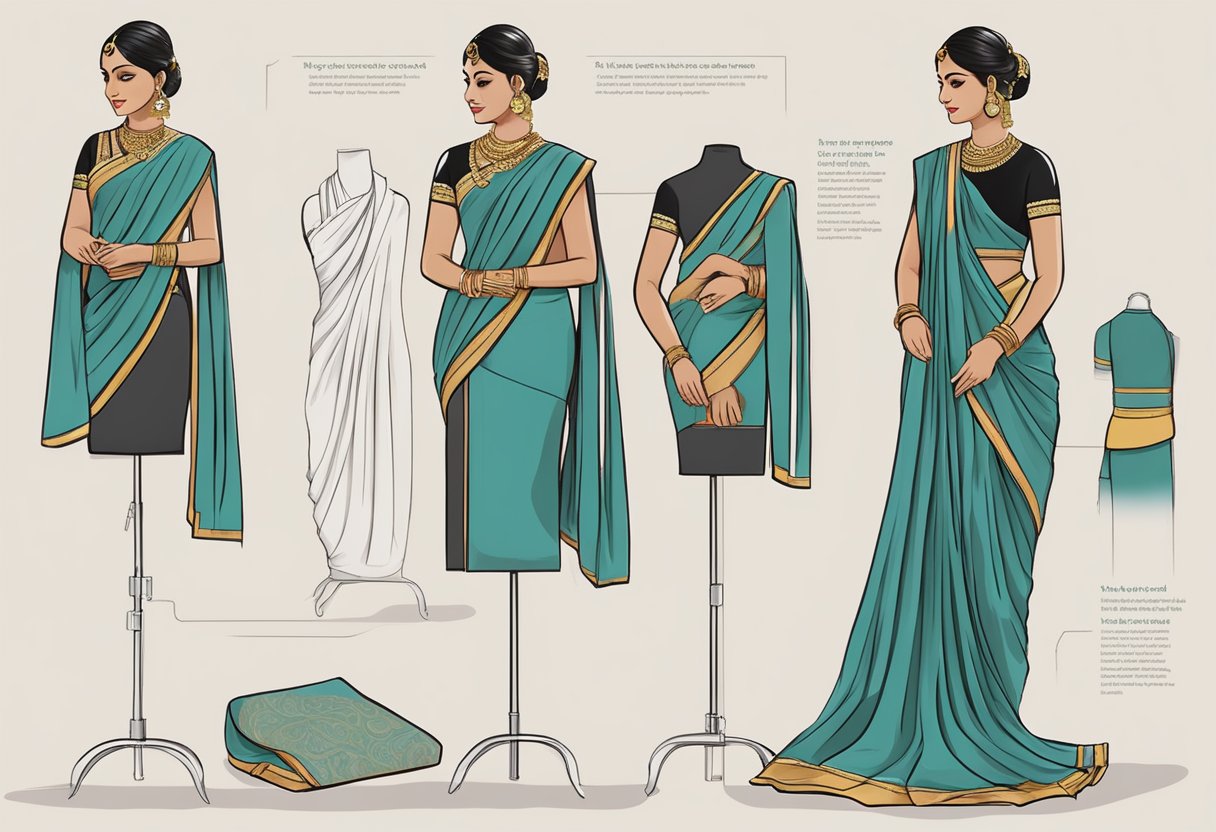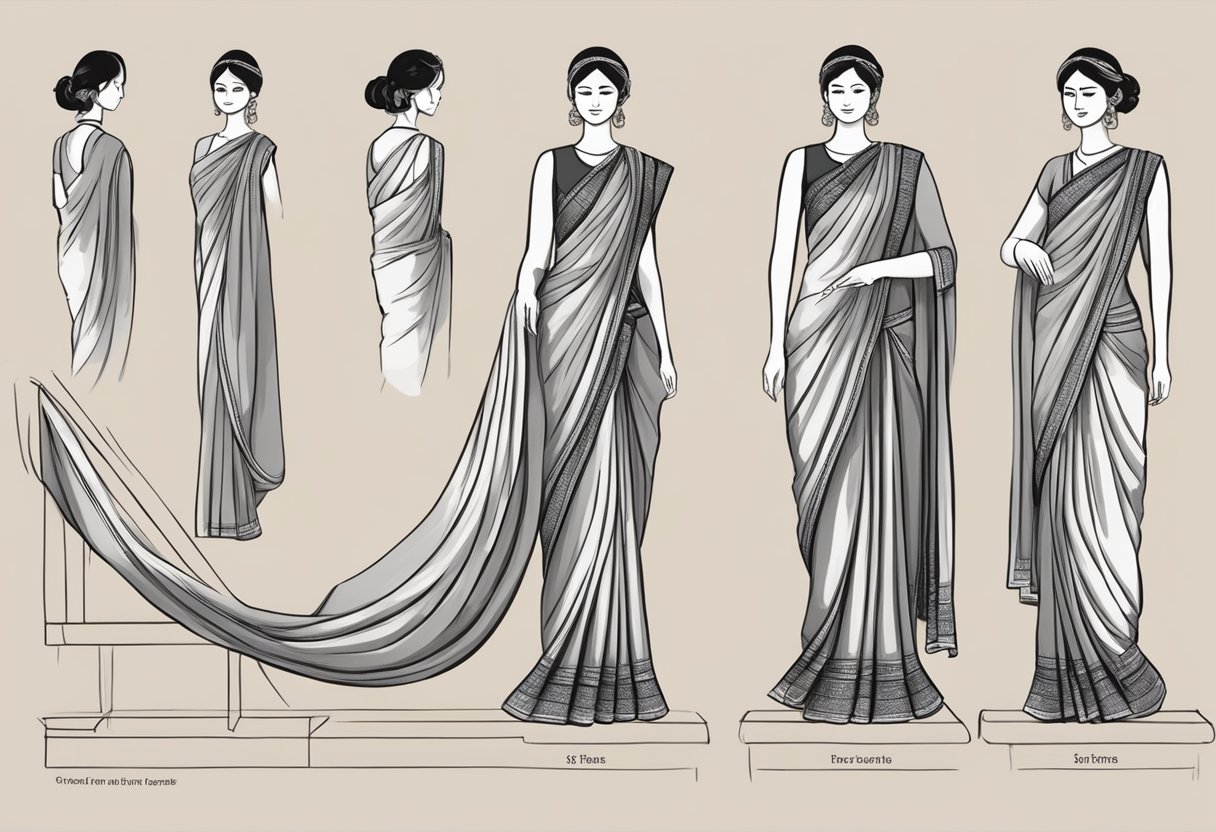The nauvari saree is a traditional garment worn by Maharashtrian women in India. It is a symbol of the rich culture and tradition that has been passed down through generations. The nauvari saree is draped in a unique style that sets it apart from other types of sarees. In this article, we will discuss how to drape a nauvari saree and the significance of this garment in Maharashtrian culture.

The nauvari saree has been a part of Maharashtrian tradition since the Maratha rule. It is a nine-yard saree that is draped in a specific way to create a dhoti-like effect on the legs. The saree is draped in such a way that it allows the wearer to move freely and perform daily tasks without any hindrance. The nauvari saree is worn on various occasions such as festivals like Gudi Padwa and Ganesh Chaturthi, weddings, and other cultural events.
Draping a nauvari saree can be a daunting task for those who are not familiar with the traditional style. However, with a little practice and patience, it can be mastered. In the following sections, we will provide step-by-step instructions on how to drape a nauvari saree and offer tips and tricks to make the process easier.
Preparing the Nauvari Saree

When it comes to wearing a nauvari saree, preparation is key. Proper preparation ensures that the saree looks elegant and stays in place throughout the day. Here are some important things to keep in mind when preparing a nauvari saree.
Choosing the Right Fabric and Design
The nauvari saree can be made from a variety of fabrics, including cotton, silk, georgette, and more. The choice of fabric depends on the occasion and personal preference. For example, a cotton nauvari saree is ideal for everyday wear, while a silk saree is more suitable for formal occasions.
In addition to the fabric, the design and pattern of the saree also play an important role in its overall look. Traditional nauvari sarees often feature intricate designs and patterns, such as the peshwai nauvari saree. However, there are also modern and contemporary designs available for those who prefer a more minimalist look.
Understanding the Length and Tucking Technique
The nauvari saree is unique in that it is worn like a dhoti, with the fabric tucked between the legs and draped over the shoulder. This technique requires a longer length of fabric than a traditional saree.
When draping the nauvari saree, it is essential to ensure that the length of the fabric is appropriate for the wearer's height. A longer length is required for taller individuals, while a shorter length is suitable for those who are shorter.
Tucking the saree properly is also crucial for a comfortable and secure fit. The fabric should be tucked tightly between the legs and around the waist to prevent it from slipping or coming loose during wear.
In summary, choosing the right fabric and design, as well as understanding the length and tucking technique, are essential components of preparing a nauvari saree for wear. With proper preparation, anyone can look elegant and stylish in this traditional Maharashtrian attire.
Draping the Nauvari Saree

The Nauvari saree is a traditional Maharashtrian saree that is draped in a unique way. It is also known as the dhoti style saree. The saree is draped in such a way that it allows for ease of movement and comfort while still exuding elegance and grace. Here is a step-by-step guide on how to drape the Nauvari saree.
Creating Pleats and Draping the Pallu
The first step is to create pleats. Take the saree and tuck it in at the center of the waist. Then, take the saree and bring it around the back and tuck it in at the right waist. Now, take the remaining fabric and make pleats. Make sure that the pleats are even and that they are facing towards the right side. Hold the pleats together and bring them to the front. Tuck them in at the center of the waist.
Next, take the remaining fabric and drape it over the left shoulder. Make sure that the pallu is long enough to reach the back of the knee. Now, take the pallu and bring it around the back and tuck it in at the right waist. This will create a V-shaped drape at the back.
Final Adjustments for Comfort and Elegance
Once the pleats and pallu are in place, it is time to make final adjustments. Start by adjusting the pleats to make sure that they are even and that they are not too tight or too loose. Then, take the pallu and adjust it to make sure that it is falling gracefully over the left shoulder.
To create the shoulder pleats, take the remaining fabric from the pallu and make small pleats. Hold the pleats together and tuck them in at the center of the waist. This will create a neat and elegant look.
Finally, make sure that the saree is comfortable to wear by adjusting the waist and shoulder pleats. The Nauvari saree is a beautiful and elegant saree that can be worn in a modern and stylish way. By following these simple steps, anyone can drape a Nauvari saree with ease and grace.
Frequently Asked Questions

What are the steps to drape a nauvari saree properly?
The nauvari saree is draped in a unique way that involves creating pleats and tucking them into the waist. The first step is to wrap the saree around the waist and make sure that the length is equal on both sides. Then, create pleats on one side and tuck them into the waist. Repeat the same process on the other side, and finally, tuck the remaining saree into the waist.
Can you explain an easy method to wear a nauvari saree?
An easy method to wear a nauvari saree is to follow the basic steps of draping. Start by wrapping the saree around the waist, making sure that the length is equal on both sides. Then, create pleats on one side and tuck them into the waist. Repeat the same process on the other side, and finally, tuck the remaining saree into the waist.
What are the different styles of draping a nauvari saree?
There are different styles of draping a nauvari saree, including the traditional Maharashtrian style, the Gujarati style, and the Bengali style. Each style has its unique way of draping and requires different techniques.
Is there a tutorial for wearing a nauvari saree with images?
Yes, there are many tutorials available online that provide step-by-step instructions on how to drape a nauvari saree. Some tutorials also include images to help you understand the process better.
How can I wear a readymade nauvari saree at home?
Wearing a readymade nauvari saree is easy and requires minimal effort. All you need to do is wrap the saree around your waist and secure it with the attached drawstring. Then, create pleats on one side and tuck them into the waist. Repeat the same process on the other side, and finally, tuck the remaining saree into the waist.
What type of fabric is recommended for a nauvari saree?
The nauvari saree is traditionally made of cotton or silk fabric. Cotton is preferred for everyday wear, while silk is worn for special occasions. It is important to choose a fabric that is comfortable and suits your needs.

